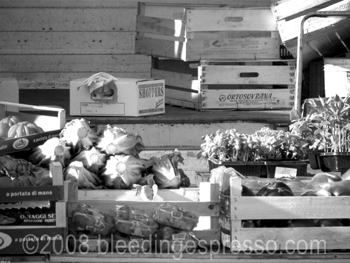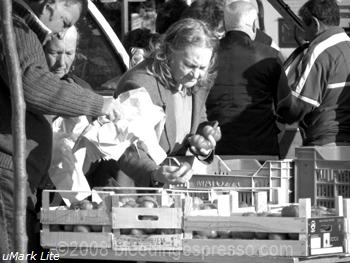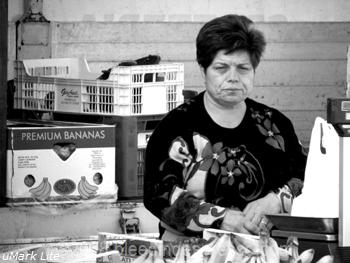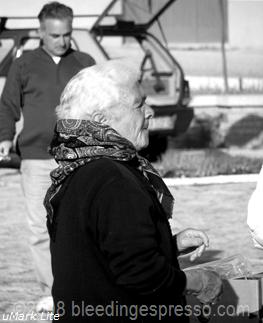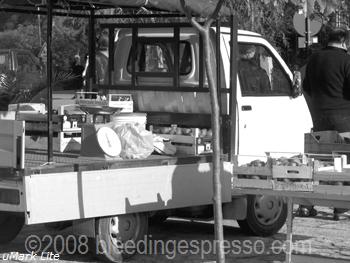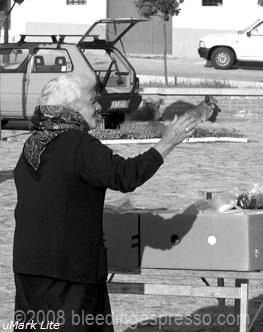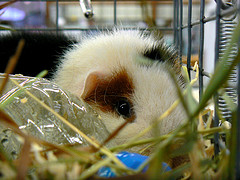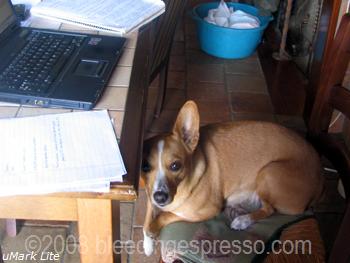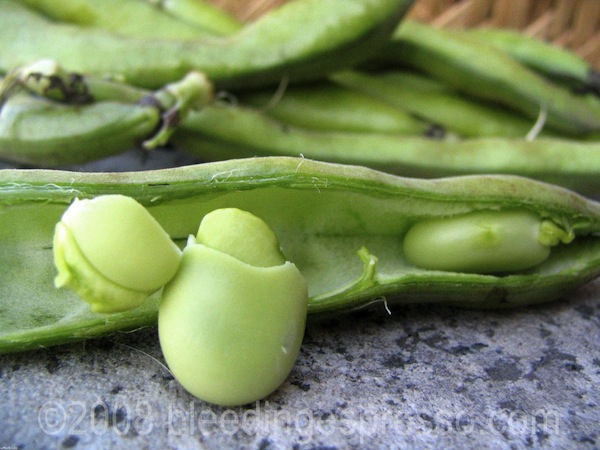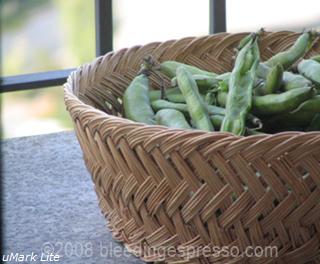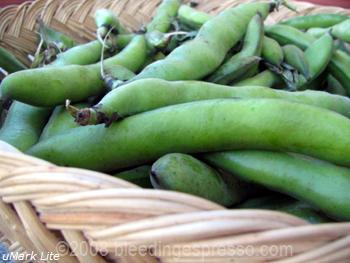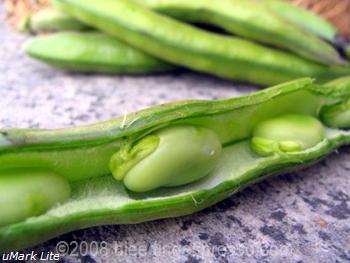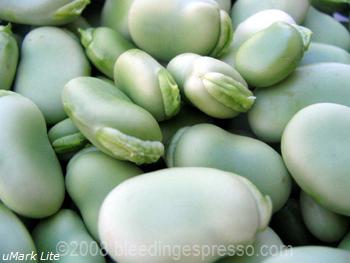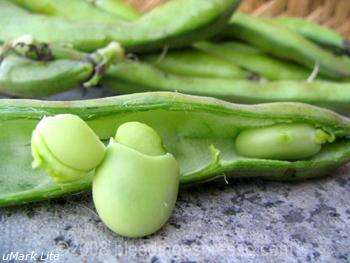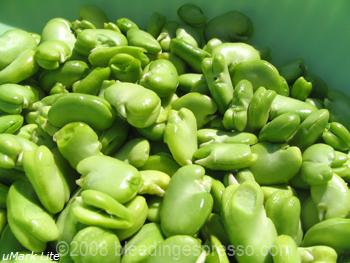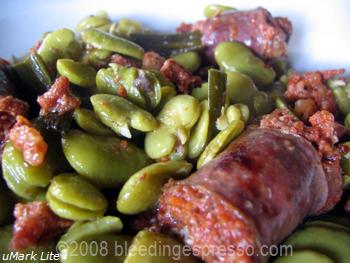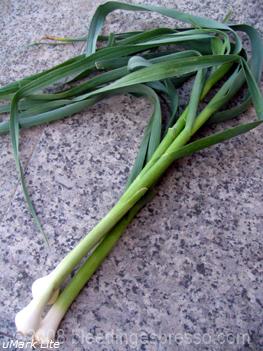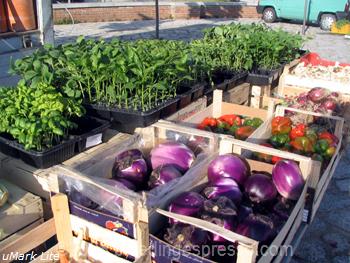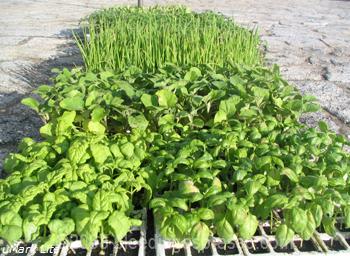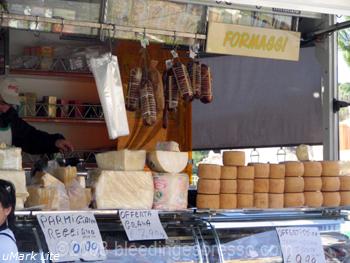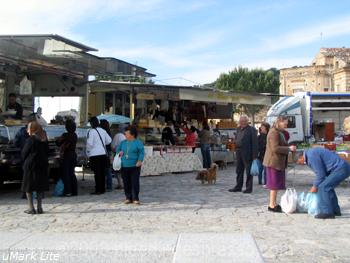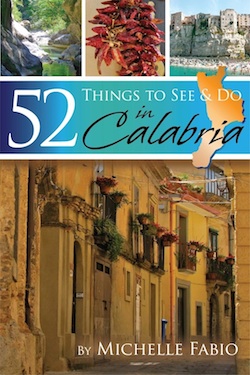Archive for the ‘life in calabria’ Category
tuesday morning market in calabria: part II
Last Tuesday we visited the weekly market in my village, and now it’s time for a little bargaining lesson.
First you should know that market prices are already lower than in the local stores–but that doesn’t mean you can’t get even better deals.
My first few Tuesdays here, I sat at the corner of the piazza and just watched the old women at work. I figured it was the best way to learn–from the pros.
I’ve often read that touching produce in Italy is a no-no, but apparently no one has told these women.
Or, more likely, the vendors are just too afraid to scold despite their tough exteriors.
Concetta (below) is one of the young old women. She’s in her early 80s, but gets around as well as anyone including me. She always smiles wide and says “Ciao Bella” while stroking the side of my face.
The first time I met her she invited me into her house and showed me photos of her entire family, including children and grandchildren spread throughout Italy, Europe, and South America as well as her husband who has passed on.
Concetta doesn’t live alone though; she lives (in sin!) with her male companion, a widower. By not getting married, she explained to me, she can still collect her deceased husband’s pensions (one from Italy and one from Switzerland). Furba, eh?
Come Tuesday morning, though, Concetta is all business. Her laughlines are well-hidden behind a poker face that truly draws fear in Pasquale, the meat truck guy.
I’ve seen her slap the hand of Totò, the man selling fruit and vegetables from the back of his Ape (AH-peh) when he tried to retrieve a carciofo from her hand.
I’ve also seen her throw up her hands in disgust and stomp away as Turi, the man with the best broccoli (I’m told) yelled after her shouting many numbers.
[The secret is to walk away; if they follow, they really want to sell.]
Concetta knows what she wants and she knows how to get it. She never leaves the market empty-handed, and always with a smile on her face.
Another successful morning for her, and another lesson in village life for me.
So, have you bargained at the market?
One (Wo)man’s Poison Is Another’s Delicacy
 Do you know the television show Bizarre Foods with Andrew Zimmern? We love it, and I may or may not have a secret crush on the host.
Do you know the television show Bizarre Foods with Andrew Zimmern? We love it, and I may or may not have a secret crush on the host.
Ahem.
In Italy, the show is called Orrori da gustare, literally Horrors to try/taste.
Sure they could’ve used the word bizzarro to describe the food, but the translators went one step further to demonstrate just how, um, eeeeeeew some of the things that Andrew eats really are–bites of lamb’s eyeballs, beating frog hearts, all kinds of rotting meat and fish and more. YUM!
So you would think that P and I wouldn’t have too much of a culture clash regarding this show because we *all* agree these foods are bizarre, if not true horrors? Right? Right? Hmm….
Through my recipes, I think I’ve demonstrated here that I like an awful lot of Calabrian food–I can get with wild boar (cinghiale) and rabbit (coniglio)–but I make no secret of my dislike of many traditional Calabrian foods, i.e., those you probably won’t be seeing on What’s Cooking Wednesday, such as:
- u suzzu: random pig parts (tongue, lungs, heart, stomach, etc.) in gelatin with peperoncino and vinegar. I like my gelatin in Jell-O thankyouverymuch.
- e frittule: boiled pig parts, especially the skin, that give off a smell I won’t even begin to describe to you because it’s turning my stomach just thinking of it.
- u sanguinazzu: a dessert made with cinnamon, orange zest, vino cotto . . . and boiled pig’s blood.
- ghiro: dormouse, usually in a tomato sauce (illegal to capture, actually).
- porcellino d’india: guinea pig. Yes, cute little guinea pigs like this:
I should be perfectly clear that I have tried three of the five on the list (care to guess?) and will probably eventually try them all if/when they are presented. I’m proud to say I’m quite Andrew Zimmern in that respect.
I *hate* when people say they don’t like something without trying it, so I practice what I preach.
And then I spit into my napkin if necessary.
Just kidding.
Sort of.
All of this is a lead-in to a conversation that P and I had the other night:
We were starving and only starting to prepare dinner as I flipped the channel to Orrori da gustare.
I quickly changed the channel.
“Oh we shouldn’t watch this now,” I said, meaning that we would be so disgusted that we’d lose our appetites.
“Yes,” P agreed.
“It’ll make me too hungry.”
Thus proving Andrew’s mantra, “One (wo)man’s poison is another’s delicacy” once again.
[P.S. Andrew, we got some poison “delicacies” for you in Calabria!]
This is all the more ironic because P is so against most “American” foods that he won’t even try them, or will only do so after I beg and plead.
Peanut butter took six months of cajoling. SIX MONTHS!
Mah.
So tell me, do you and your Other Half agree on food?
What foods gross you out?
What’s the most bizarre food you’ve ever tried?
P.S. Be sure to check out some decidedly delicious food–
Mary’s Crab Cakes at The Flavors of Abruzzo
for La Buona Cucina Americana!
Buon weekend!
love thursday: my own personal seat warmer
Many people mistakenly believe that the weather in southern Italy is tropical or nearly so. It really isn’t. We do have seasons, although winter brings more rain than snow and spring can seem awfully short before we are thrust into the heat of summer.
Another southern Italian factoid is that most of the houses here are built with stone and/or tile, i.e., with “natural insulation”; central air and heat are only coming into fashion now, but it’s still quite expensive to run because of electricity costs.
And so most of us are “green” without even really trying.
All of this means that if your house isn’t directly in the sun, it can get pretty darned cold inside and stay that way–even now, in the spring when I often have to take *off* layers of clothes to go out with the dogs.
[This cooling effect works a bit in our favor during the summer, although not as much as it seems to work against us in the colder temps.]
Anyway, I am so very pleased to announce that it has been nearly a week since I’ve had to turn on the space heater near my work area, which means spring truly has arrived!
It also means I’ve had to switch to another method of keeping my seat warm:
All natural, and works for us!
Happy Love Thursday everyone!
P.S. Yes this photo sums up my life rather well–
work, pooches, and laundry in the big blue vasca.
What’s Cooking Wednesday: Calabrian Sausage & Fava Beans
 You had to know it was only a matter of time before fava beans made an appearance on What’s Cooking Wednesday.
You had to know it was only a matter of time before fava beans made an appearance on What’s Cooking Wednesday.
Fava beans (also known as broad beans and “fava” in Italian, “fave” is plural) are peasant food at its finest, and if there’s one thing we do well in Calabria, it’s peasant.
I wrote about favas before they start coming into season right around St. Joseph’s Day in March; now we’re at the end of the fava run. Mostly we just eat them raw as a snack (more info on how you get to that point below), but when P’s mom brought a big ole bag of them over, we had an urge to cook them.
And yes, that could also be because “Fabio” comes from faba…Latin for fava! It’s in our DNA around here.
Normally P’s mom would use “carne salata” (a very salty cured meat) with this dish, but we didn’t have any so we used spicy Calabrian sausage. Pancetta or bacon could also easily be substituted.
While researching for the post, I came across this recipe from medieval times–not only is the recipe quite similar to what P’s mom would make, there are words in there more reminiscent of Sicilian/Calabrian than standard Italian. Interesting, huh?
Before we get to the recipe, let’s get something clear before you start–you have to *really* want to eat favas to go through the work involved. Susan of Food Blogga, gives a great demonstration of shelling them here, and now a quick lesson from me.
They start looking like this:
Snap off the top of the pod and pull down so the pod splits at the seam (or otherwise twist and turn the thing until you expose the beans):
Remove the beans and throw away the pods so that you’re looking at a bunch of beans like this:
You’re not done yet! Now you have to take off the outer casing as well, otherwise you could be in for some nasty digestion issues later.
Susan recommends boiling the beans and then plunging them in ice water, but I just peeled off the little “handle” on top and then squeezed out the beans.
Now your favas are shelled and ready to eat raw or cook.
I told you. You have to want these.
If you’re in the right frame of mind, shelling favas can be an extremely relaxing experience as it was for me. Yes, my thumbs hurt a little bit afterwards, but you know what they say:
No pain, no favas.
They are worth it, I promise, especially since this recipe has only four ingredients. Easy peasy! Or, easy fava-y? And as I told P, it’s fava-loso.
OK I’ll stop now.
Calabrian sausage & fava beans
(Salsiccia calabrese con le fave)
4 tablespoons olive oil
2 links of spicy sausage, cut into chunks
4 garlic sprouts, chopped
Pile of favas
Salt to taste
1. Heat oil in medium pan and add sausage. Let cook for about 10 minutes until the sausage releases some of its fat and flavor into the oil.
2. Add garlic sprouts and beans and cook until beans are tender but not overcooked, about 15-20 minutes, testing often.
3. Adjust for salt.
4. Serve with fresh, crusty bread, and this is a delicious, hearty meal on its own.
Notes:
1. The green attached to the end of this fresh garlic is what I mean by garlic sprouts. The first time P’s mom called these “code” (COH-deh) or garlic tails, I just had to smile. Isn’t that a great name? Don’t you love Italian?
2. I think this recipe would be great with tomatoes thrown in too, but P wasn’t feeling adventurous, so we did it without. Maybe next fava season.
Buon appetito!
Have you tried fava beans?
What’s your favorite way to enjoy them?
Tuesday Morning Market in Calabria: Part I
Every Tuesday morning, vendors of fruit,
vegetables,
herbs,
meats and cheese,
(especially local cheese)
hold a mercatino in the main square of the village.
And when I say morning, if you’re not there before 10 a.m., well, you’ll just have to wait until next week.
Speaking of which, be sure come back next Tuesday for Part II of Tuesday Morning Market in Calabria for a lesson from a pro in how to get a good deal and lots more photos!
What would you buy at the weekly mercatino in my village?

